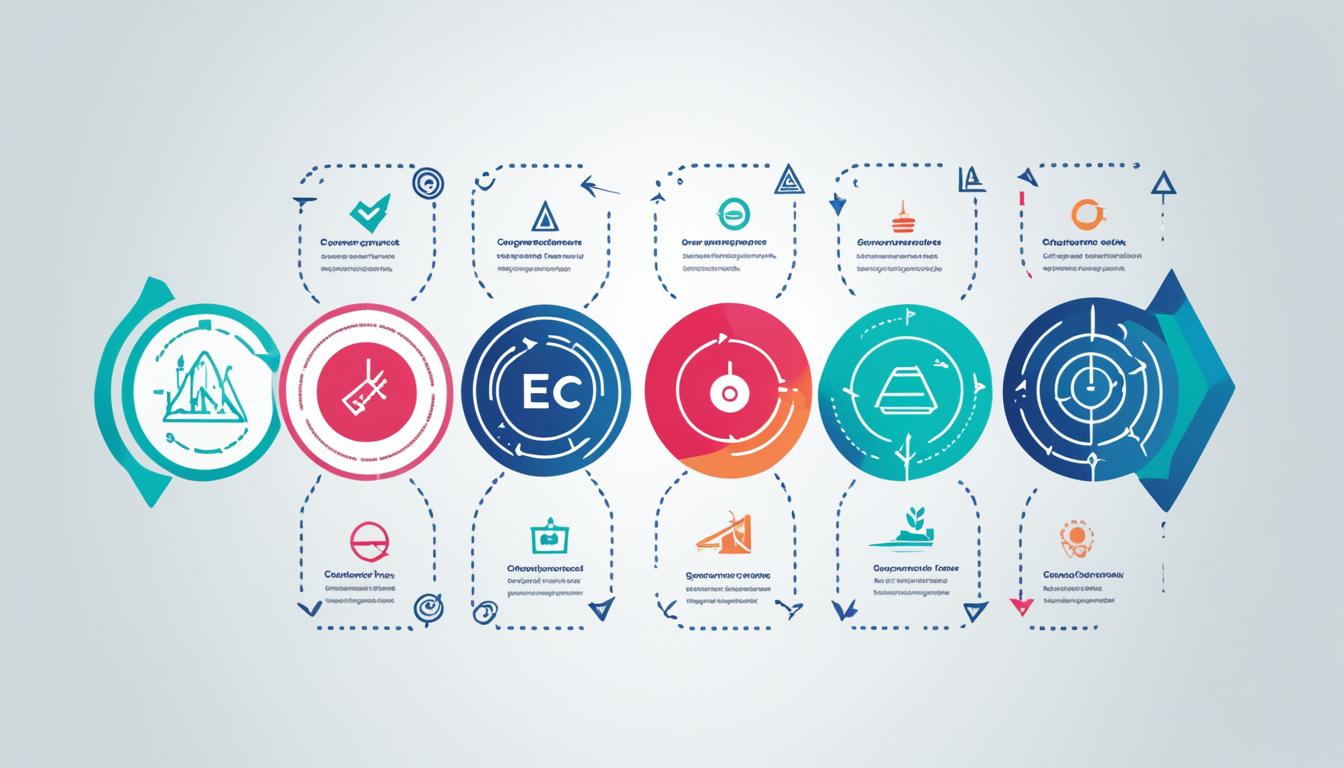Did you know that 75% of businesses see better productivity and happier workers with set policies? Policies aren’t just rules. They’re key to keeping things consistent, people productive, and the work atmosphere positive.
This guide will show you how to write policies step by step. You’ll learn about planning, helpful tips, how to implement them, and see examples. We’ll explain why managing policies matters. And, we’ll introduce you to SweetProcess — a tool that makes writing and managing policies easier. By the end, you’ll know how to make policies that fit your company’s goals and values.
Key Takeaways:
- Defined policies and procedures can lead to improved employee productivity and satisfaction.
- Policies promote consistency, productivity, and a positive work culture.
- This guide will provide a step-by-step process of policy writing, tips, and best practices.
- SweetProcess is a powerful tool that simplifies policy writing and management.
- Create policies that align with your organization’s vision and values.
Writing the Policy: A Step-by-Step Guide
Making good policies needs careful planning and focus. Use this guide when writing policies. This ensures they are clear, detailed, and simple to follow.
1. Prepare
Start by researching your organization’s goals, values, and what it aims to achieve. This makes sure your policy fits with these goals. Look at current policies too. This prevents overlap or conflicts.
Here’s a tip: Talk with key people to hear their thoughts. Their views help the policy meet various needs within your organization.
2. Organize and Prioritize
Sort your policies by their purpose and scope. This step makes them easier to find and understand for employees.
Then, decide which policies are most urgent or important. This lets you tackle the ones that affect your work right away.
3. Policy Elements
When writing a policy, include the following essential elements:
- Purpose and Scope: Clearly explain what the policy aims to do and who it’s for.
- Responsibilities: Say who is responsible for what under this policy.
- Policy Statement: Share the main goal of the policy and its importance.
- Procedures and Guidelines: Give clear instructions and guidelines to follow the policy.
- Compliance and Consequences: Tell the outcomes of not following the policy and why it matters.
Another tip: Get input from experts and stakeholders. Their advice ensures your policy covers everything it needs to.
4. Review and Approval
Check your policy for clarity, consistency, and legal standards.
Make your policy look good and easy to read. Use headings and lists to help.
Get the okay from key people. This makes sure your policy fits with what’s required legally and by your organization.
5. Effective Communication
Good communication is key to putting a policy in place. Share the policy in a way that’s easy for everyone to get and use.
You might use a handbook, intranet, or policy system. This makes sure everyone can find and follow the policy.
Here’s another tip: Offer training to help employees understand the policy. Address their questions or worries.
Policies need to stay current. Review and update them as needed. Writing policies is ongoing, needing regular checks and tweaks.

| Benefits of a Well-Written Policy | Tips for Effective Policy Writing | Best Practices for Policy Implementation |
|---|---|---|
| 1. Ensures consistency across the organization. | 1. Use clear and concise language. | 1. Communicate policy changes proactively. |
| 2. Reduces the risk of non-compliance. | 2. Structure the policy logically. | 2. Provide training and support for employees. |
| 3. Promotes a positive work culture. | 3. Use examples and case studies to illustrate the policy’s application. | 3. Regularly review and update policies. |
How to Use SweetProcess for Policy Writing
SweetProcess is a powerful policy writing tool that makes writing and managing policies easy. Its user-friendly interface and intuitive features make creating policies simple.
We will show you how to use SweetProcess for policy writing, step by step. It’s great for new policies or managing existing ones. SweetProcess has everything you need.
Manual Policy Writing
If you like to write policies yourself, SweetProcess has a simple manual feature. Just follow these steps:
- Login to your SweetProcess account and go to the “Policies” section.
- Click the “Create New Policy” button.
- Give your policy a clear title.
- Write your policy using the provided editor.
- Use headings, bullet points, and lists to make it readable.
- Add important sections like purpose, scope, and procedures.
- Save and check your policy for corrections.
- Once happy, publish it for your team to see.
This manual approach lets you make sure your policy matches your organization’s needs perfectly.
Automatic Policy Generation with SweetAI
SweetProcess also has SweetAI for automatic policy writing. Here’s how to use it:
- Log into SweetProcess and find the “Policies” section.
- Press the “Generate New Policy” button.
- Pick a category or topic for your policy.
- Decide how detailed or customized you want it.
- Mention any important rules or compliance needs.
- SweetAI creates a draft policy for you.
- Review and edit this draft to make sure it’s right.
- Save, publish, and share your new policy with the team.
This automated feature is a huge time-saver, especially for common topics or compliance needs.
Managing Existing Policies
To manage your policies well, follow these steps with SweetProcess:
- Login and visit the “Policies” section of SweetProcess.
- Find the policy you need to work on.
- Update or revise the policy as needed.
- Keep track of versions and changes for audits.
- Set owners and responsibilities for each policy.
- Turn on notifications for updates on policy changes.
- Archive or delete out-of-date policies to keep things tidy.
With SweetProcess, managing policies is easy. It keeps everything organized and accessible for your team.

As the screenshot shows, SweetProcess has a clear interface that eases policy writing and management. Its design helps you navigate and create policies quickly and efficiently.
SweetProcess’s step-by-step instructions, screenshots, and videos make learning policy writing easy. Use SweetProcess to streamline your policy management and make your organization run smoother.
Why Policies and Procedures Matter to Your Organization
Policies and procedures are vital for every organization, regardless of the field. They help promote consistency and reduce the risks of not following rules. Plus, they boost how efficiently an organization runs.
Policies give guidelines that make sure employees know and follow the organization’s core values, expectations, and best methods. By setting out clear rules, policies create a structure for making choices. They ensure everyone in the organization understands what to do.
Procedures show how to put these policies into action in a clear, step-by-step way. They guide employees through the necessary processes to follow policies correctly.
When it comes to dealing with problems or crises, having good policies and procedures is key. They set out clear steps for solving issues quickly and well. This helps an organization handle unexpected events, reducing risks and lessening any negative effects on business.
Additionally, policies and procedures make internal processes better. They clear up any confusion on how tasks should be done, making things run smoother. With clear policies and procedures, employees can work more effectively. This leads to better productivity and overall performance.
Following laws and industry standards is a must for any organization. Policies and procedures make sure an organization meets these legal and ethical requirements. They help avoid fines, legal troubles, and damage to the organization’s reputation that might come from not following these rules.
Setting up thorough policies and procedures helps create a trustworthy brand image. It shows customers, clients, and partners that the organization is honest, responsible, and open. This improves the organization’s reputation and helps build long-lasting business relationships.
In summary, policies and procedures are critical for keeping an organization on track, ensuring it follows laws, and making it run efficiently. They bring clarity, consistence, and structure, making it easier for employees to do their jobs. They also help in creating a strong culture and a good reputation for the organization. By focusing on developing and using effective policies and procedures, an organization can protect its operations, reduce risks, and succeed in the long run.

Conclusion
Policies and procedures are key for organizations to set clear rules and ensure they follow laws. These rules help maintain consistency, improve efficiency, and create a better work atmosphere. Writing and managing policies well is crucial for an organization’s success and safety.
This article’s step-by-step guide and tools like SweetProcess help organizations develop detailed and workable policies. It’s important to regularly review and update these policies. This ensures they stay current with legal and industry standards.
Policies are more than just rules; they are the backbone of trust, responsibility, and good reputation in a company. A forward-thinking approach to managing policies makes operations flow smoothly and makes the workplace better.

